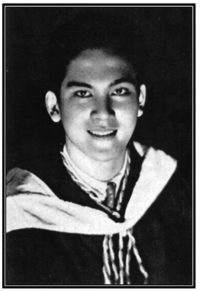The weather has postponed entry of the Americans into Japan. The first detachments were scheduled to land today with the formal surrender ceremony set for the 31st aboard the battleship Missouri. Instead, according to joint communique of the Imperial Government and Imperial General Headquarters, the first entry will be postponed 48 hours to the 28th; the surrender ceremony will consequently take place on the 2nd September.
Meantime Japanese preparations continue. On the 23rd a full-time war minister was finally appointed, General Tadaishi Shimomura, supreme commander of the Japanese forces in North China, who is said to have acquired some experience in diplomacy as a delegate to the 1931 disarmament conference and the league of nations. He also worked on the commission to enforce the Versailles Treaty.
Yesterday the 25th the emperor issued a second rescript to the army and navy, informing them: “In accordance with the trend of the times We wish to lay aside arms and to abolish armaments. It is with heart-rending grief that We think of our Ancestral Precepts and the loyalty so long offered by Our officers and men. We extend Our sympathy to the many officers and men who have fallen in battle or died of illness. In abolishing armaments We wish that the demobilization be materialized in a prompt and orderly manner so as to crown the Imperial Forces with perfection. Ye officers and men,” ends the rescript in one more appeal, “take up civil occupations in obedience to Our wish, endure hardships and the thorns that strew your road, and thereby endeavor for post-war reconstruction.” In addition three imperial princes have been dispatched to the different fighting fronts to enforce surrender with the full prestige of the imperial throne.
The government has also started to reform its wartime structure. The supreme war council will be abolished and its place taken by a “postwar disposal council” with a “postwar routine liaison commission”. An extraordinary session of the diet will be called on the 1st September with the purpose of “acquainting the people thoroughly with the circumstances leading to the termination of the war and urging them to undertake the rebuilding of national fortunes.” The Great Japan Political Party has already announced its plans for an early dissolution.
Various other wartime offices will also be closed, principally the Daitoa and munitions ministries, the air defense general headquarters, the underground construction headquarters, and the students’ mobilization bureau.
Other pre-surrender notes: the people have been warned that American plans are dropping supplies by parachute to the 13 internment camps for foreigners. Several people have been killed by these packages, it seems.
Of the 34 American and British nuns recently released from internment camp, only two wanted to go home for a visit. An American Catholic priest, the Rt. Rev. P.J. Byrnes, has appealed to his countrymen, through the Asahi, to “come with feeling hearts with the idea of befriending the Japanese.” He has also assured Japanese fathers and mothers that they need have no fear.
For the time being, due to the shortage of food and housing, the restrictions on the return of evacuees to Japan’s six big cities will be maintained.
The former welfare minister has presented to the imperial family a new kind of bread made of starch dregs, unhulled rice, acorns, pigweed, and clover leaves.
The papers are again carrying weather reports.
A wave of resignations is taking place among government officials.
To minimize inflation the retirement allowances hitherto paid to munitions workers will be given in the form of three-month fixed deposits.
Travel restrictions applied to foreigners in Japan will be lifted on the 31st.
The restrictions on labor have also been abolished, except for day-laborers. Hitherto males from 14 to 40 have been barred from 17 occupations, including barbering and bath-house management.
Explaining the stay-away railroad strike of the 16th August, the director-general of the railway general affairs board declared: “Every driver and engineer, nay every railway employee, exerted his utmost efforts during the war in the same spirit manifested by the men of the special attack corps. Upon receiving the news of the end of the war they were extremely disappointed and many of them did not come to work. I hope the people will sympathize with the despair and disillusion that swept over them. The fact that at least 20 to 30 of them, and sometimes 300, fell victims to enemy air-raids daily attests to their gallantry.”
More and more of the secret figures of the war are coming to light. On the 25th, air defense general headquarters revealed that air-raids caused a total of 260,000 deaths; wounded numbered 420,000 and sufferers in general, excluding those killed and injured, some 9 million. A total of 2,210,000 houses were burned or destroyed with 90,000 partially damaged. Only nine prefectures escaped with minor damage. Of the 206 cities, 81 were heavily damaged (30 per cent of the houses burned or seriously damaged).
The air arms board of the munitions ministry in turn issued a statement which may constitute a passing epitaph of Japan’s war effort. It read in part: “The monthly output of airplanes during the early stages of the Greater East Asia war was only about 500, both army and navy planes combined, but in June last year it showed promise of exceeding 3,000. In spite of severe damage to the production capacity by air-raids after July this year the production still maintained the 1,000 mark.”
